The next-gen MacBook Pro with Retina Display Review
by Anand Lal Shimpi on June 23, 2012 4:14 AM EST- Posted in
- Mac
- Apple
- MacBook Pro
- Laptops
- Notebooks
Vastly Improved Thermals
When the 2011 MacBook Pro hit I was so excited because it finally gave me a fairly portable chassis with my definition of a “fast-enough” CPU: a quad-core Sandy Bridge. As always, there’s a downside to being an early adopter. In this case the downside to buying Apple’s first quad-core notebook was that it got incredibly hot and was fairly loud at that.
It had good reason for being a space heater. Intel crammed nearly a billion transistors on its 32nm process into the quad-core Sandy Bridge. AMD contributed over 700 million transistors on TSMC’s 40nm process with the Radeon HD 6750M, and when you used the two in tandem things got bad.
A bunch of ridiculously smart fab engineers in pursuit of maintaining Moore’s Law gave us improvements on both fronts. Ivy Bridge uses Intel’s brand new 22nm 3D transistors, while NVIDIA’s GeForce GT 650M (codename: Kepler) uses TSMC’s 28nm process. Both architectures are very focused on power reduction and it shows.
To understand the improvement that the Retina MacBook Pro offers over its predecessor we need to really understand where last year’s model suffered. To put things in perspective I created three experiments, two focused on the CPU’s thermal behavior and one on the CPU and GPU.
To start I took Cinebench and ran its single threaded test over and over again, plotting performance vs. number of runs. I ran the test for about 20 minutes before calling it quits. As you can see both the 2011 MacBook Pro and 2012 rMBP delivered consistent performance between runs:
Subjectively, fan speed wasn’t an issue on either system during this test. The fans never ramped up to full speed on either machine, which tells me that despite the CPUs supporting Turbo Boost neither chip is actually dissipating all 45W allocated during this test. It’s possible the chips could be clocked higher, or just as likely that thermal hotspotting (dense areas of transistors that get too hot) is preventing them from running at higher frequencies - not the overall power budget of the chip.
The next test uses Cinebench but instead focuses on the multithreaded benchmark. Here all four cores (and eight threads) are engaged across both systems. I ran these tests, back to back, for around 20 minutes straight. Despite the increased load, neither system shows any throttling of performance:
Fan speeds definitely ramped up here, stabilizing at their maximum spinning speeds of just over 6000 RPM. The Retina MacBook Pro is subjectively quieter but I’ll discuss that in greater detail shortly.
The final experiment focuses on a hardly stressful game by today’s standards: Half Life 2 Episode Two. Once again, for approximately 20 minutes I ran our standard macbench timedemo test in HL2. I ran both systems at 1680 x 1050, without AA, but with all other quality settings maxed out. This is a bit more stressful than 20 minutes of actual gameplay since the timedemo runs renders all frames as quickly as possible rather than playing back the demo in real time. In the end it worked out to be nearly 40 consecutive runs of our benchmark.
The graph below gives you an idea of what happens to performance over time:
I’ve adjusted the y-axis on the chart to exaggerate the impact here a bit, but you get a clear idea of just how much heat both of these chips were putting out in the 2011 MBP. Either the CPU or GPU (or both) have to be throttled back over time in order to stay within their thermal and power budgets. As a result, in the 2011 15-inch MacBook Pro, performance drops by over 20% over the course of 20 minutes of this test.
The MacBook Pro with Retina Display, on the other hand, remains relatively stable across all runs. While its performance definitely dips, the impact is around 5% off of peak.
Intel and NVIDIA are really to thank here as both Ivy Bridge and Kepler are really mobile focused. Kepler in particular was a dramatic leap forward in power efficiency as we saw from our deep-dive on the architecture. Intel’s 22nm process, while relatively unimpressive on the desktop (a 10W savings isn’t anything to write home about in a tower) makes its first dramatic impact in the next-gen MacBook Pro.
Apple does play a role in the improved thermals of the Retina Display equipped MacBook Pro. Although very similar to the unibody chassis that Apple has been shipping for the past few years, the cooling system is significantly revamped.
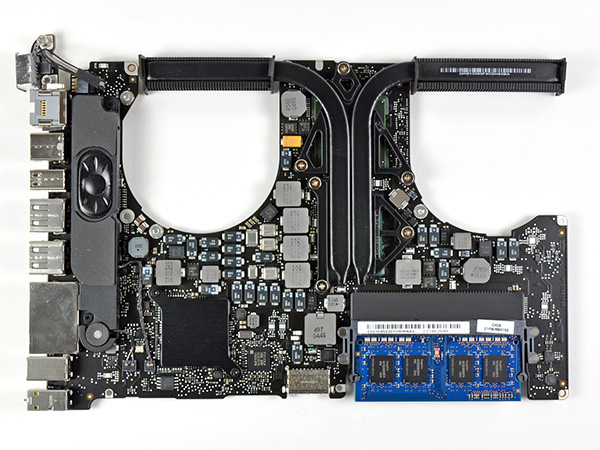
2011 15-inch MacBook Pro heatsink, iFixit
The previous generation 15-inch MacBook Pro featured two fans, each cooling a heatpipe that ran across the CPU and GPU. The two were treated as thermal equals with neither residing in the heat shadow of the other. By running both heatpipes over both chips Apple guaranteed equal cooling when both chips were active, or quieter operation when only one was doing significant work. With the traditional MacBook Pro design, air was exchanged in a single location: along the display hinge.
The next-gen MacBook Pro still retains the two fan design, but there’s now a single large heatpipe that runs across both the CPU and GPU. Heatsink thickness appears to have been reduced as well, a concession made in order to decrease the overall z-height of the rMBP. The entire construction looks far more MacBook Air-like, which makes sense given the design of the notebook.

The rMBP heatsink, iFixit
Air is now moved through three sides of the notebook. Small slits on the left and right sides of the MacBook Pro act as intakes, while warm air is still exhausted out of the rear.
Apple also went to an new fan design with asymmetrically spaced blades. The idea is that by changing blade spacing you produce a sound that is spread out over more frequencies, and thus appears quieter.
The combination of silicon changes, side intakes and fan design results in three things:
1) Under light use the rMBP’s fans are virtually inaudible compared to the previous generation. In a quiet room you can still hear them spinning but it’s a significant improvement over last year’s model. Originally I thought the fans simply spun slower but running a light workload both last year's MBP and the rMBP spin their fans at 2000 RPM. The rMBP's fans simply sound quieter.
2) Under moderate use the fans in the rMBP are generally quieter than in the previous generation. Again this is likely due to the 22/28nm silicon in combination with the improved cooling system.
3) Under heavy use the rMBP fans are definitely audible, but the sound is different than what you get with the previous model. I was disappointed at first because I was expecting a dramatic reduction in noise, but instead I got the sort of improvement that you really notice once you go back to the older system.
To give you a sense of how the two sound I’ve embedded two audio clips of the 2011 15-inch MacBook Pro and MacBook Pro with Retina Display running a multithreaded Cinebench 11.5 test. In both clips you can hear me open the lid on the sleeping machine, quit open apps, use Spotlight to run Cinebench and click to start the benchmark (and click to repeat the test throughout the recording).
Neither system can make it through a single run of this test without ramping up the fans but note how quiet the Retina MBP remains in the early part of the test. Although the rMBP fans sound louder towards the end of the recordings, in person they actually sound quieter. Unfortunately I didn't have a good setup to really convey that.
Many have you have asked for specifics on thermal and acoustic performance. Here you go.
I ran both the upgraded 2011 MacBook Pro and Retina MacBook Pro through the same Half Life 2 torture test I described above, but at even more stressful GPU settings (1680 x 1050 with 4X AA enabled). I measured surface temperatures at the top and bottom of the notebook, as well as noise 3 inches above the trackpad on both systems. The results are in the table below:
| 2011 MacBook Pro (Core i7 2.3GHz, 6750M) | Retina MacBook Pro (Core i7 2.6GHz, GT 650M) | |
| Max CPU Temp | 75C | 63C |
| Max GPU Temp | 69C | 72C |
| Max Surface Temperature (Top) | 47.3C | 49.8C |
| Max Surface Temperature (Bottom) | 49.8C | 41.8C |
| Max Noise (3" Above Trackpad) | 53.4dB | 51.3dB |
In this particular test we see the two machines trade blows. The Retina MBP actually has a higher surface temperature on the top of the machine, but the underside remains significantly cooler. I believe the tradeoff is honestly worth it as the new machine has a tangible impact on how hot your lap gets. The Retina MBP is also noticeably quieter during this run, although it does technically let the GPU get a little hotter than last year's system. CPU temperatures are down considerably as well but we're also comparing 32nm vs. 22nm silicon at potentially different leakage levels.
Overall I’d consider the acoustic and thermal improvements here to be significant. Apple’s Phil Schiller got some of his strongest applause from the audience when he mentioned the fan design at the rMBP’s WWDC introduction. It’s attention to detail that Apple earns a lot of bonus points for; the fan design in the next-gen MacBook Pro isn’t revolutionary but it’s a tangible improvement that I can appreciate.


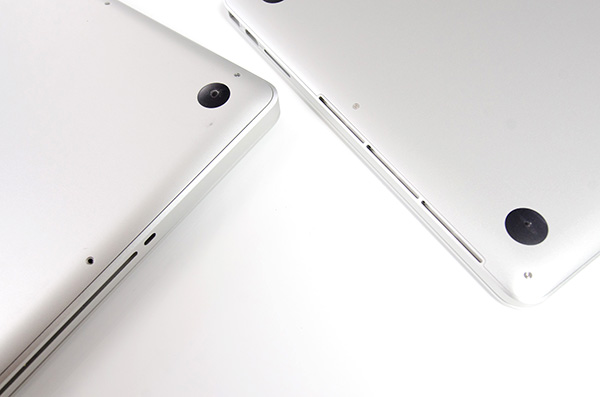
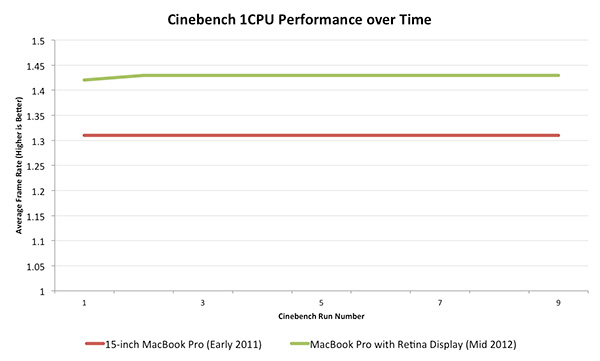
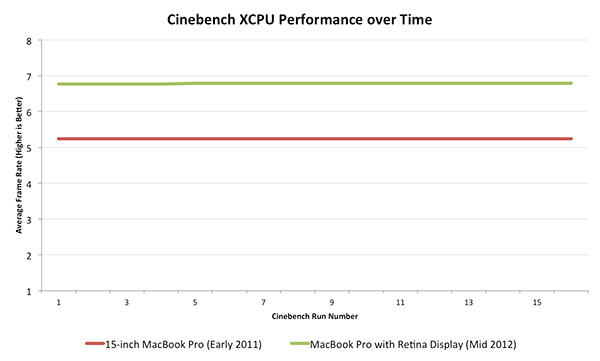
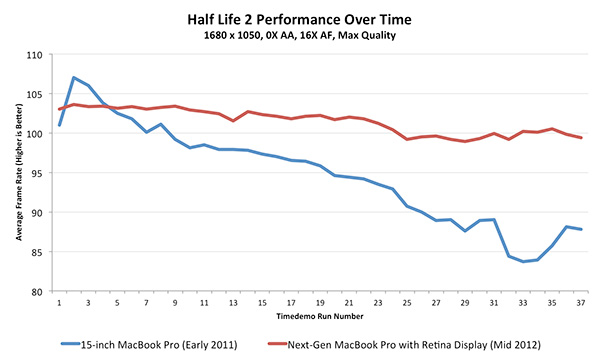
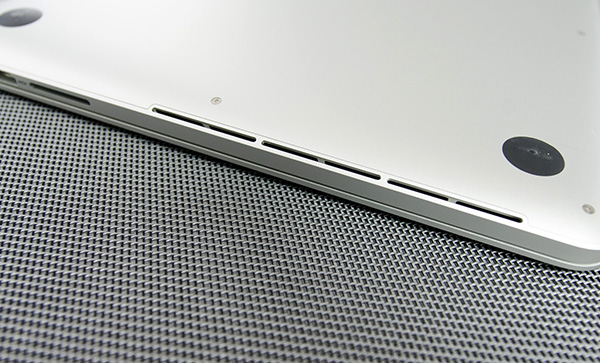








471 Comments
View All Comments
seapeople - Sunday, June 24, 2012 - link
Wow, is that the Sony everyone here has been harping about "outdoing Apple" years ago?Reading that review basically says that while the general specs of that Sony are outstanding, every other possible aspect of user experience (keyboard, hinge design, trackpad, thermals, and noise) is completely terrible.
Oh, and it looks like it costs more than the rMBP and comes loaded with bloatware.
There's a reason that didn't get an Editor's choice award, and it's not some great conspiracy...
OCedHrt - Monday, June 25, 2012 - link
Not really. You can buy it without the bloatware, you just need to select Windows Pro. They got a review unit from Sony, and Sony shipped them their "consumer" version which is loaded with bloatware (although I agree, that is even more reason to not have bloatware).The hinge is by design and something Sony engineers are quite proud of. Not everyone likes it when something is different, especially when it comes to keyboards.
Simply read the comments (http://www.anandtech.com/Show/Index/5530?cPage=5&a... and you can see only the reviewer had an issue with the hinge that he couldn't even explain very well.
I have been using the Z1 for 2 years now and the experience is awesome. It may just take some time to get used to a small laptop.
Trackpad can glitch every once in a while and for noise you can make it silent in the Sony control center (change fan from performance to silent).
There is always going to be fan noise in a high end laptop when stressing the system. This applies to the rMBP as well (http://forums.macrumors.com/showthread.php?t=13918...
Spunjji - Tuesday, June 26, 2012 - link
Moron.mlambert890 - Thursday, November 29, 2012 - link
Were you two on the design team of the Z? LOL!You just called the guy a moron for pointing out why *ANAND* didnt like the Z.
OK you guys are right. The Z is amazing and it is a crime against humanity that only you and your fellow crusader "get it". Sony should be the #1 PC maker rather than approaching junk bond status and it is only Apples "marketing hype" their ability to "buy off" guys like Anand and the "stupidity" of everyone on earth (except you two) that keeps Apple profitable. What an amazingly arrogant pile of crap that is
Im a huge Vaio fan and Im 100% sure Ive spent more on them than you two have combined over the years and even *I* think the two of you sound nuts.
UltraTech79 - Saturday, June 23, 2012 - link
You're talking out your ass.KoolAidMan1 - Saturday, June 23, 2012 - link
Amazing argument.Truth hurts dude, sorry
KoolAidMan1 - Saturday, June 23, 2012 - link
Nothing you noted is cutting edge, and it is also thicker and heavier than Apple's machinesOCedHrt - Sunday, June 24, 2012 - link
How is 2.5 lbs and 0.66" thick thicker and heavier than Apple's machines? Apple does not have a single laptop lighter and thinner than Sony's Z. Not even the ridiculously slow MBA can compete.KoolAidMan1 - Monday, June 25, 2012 - link
Since when were Ivy Bridge i5 and i7 CPUs ridiculously slow?Spunjji - Tuesday, June 26, 2012 - link
Comparatively? Since forever. Stop trying to undermine people's valid arguments by failing to read them, jackass.